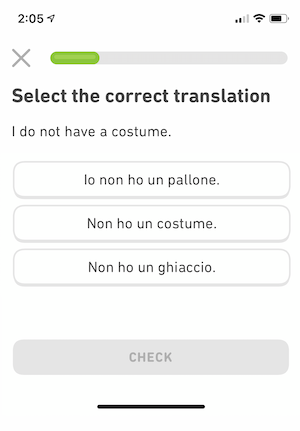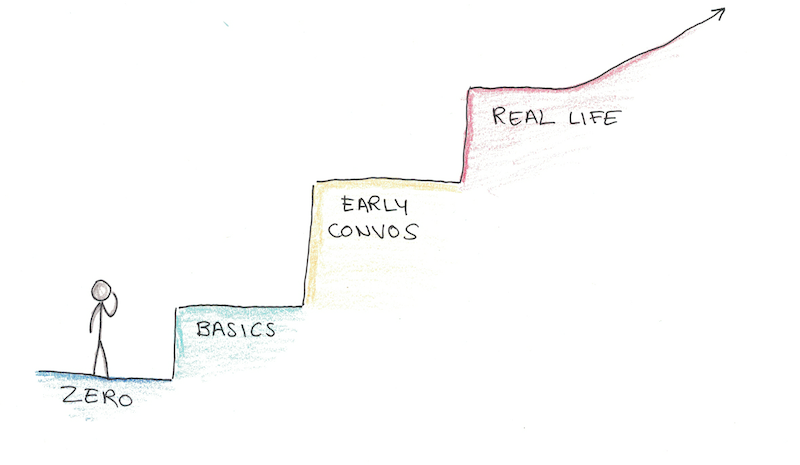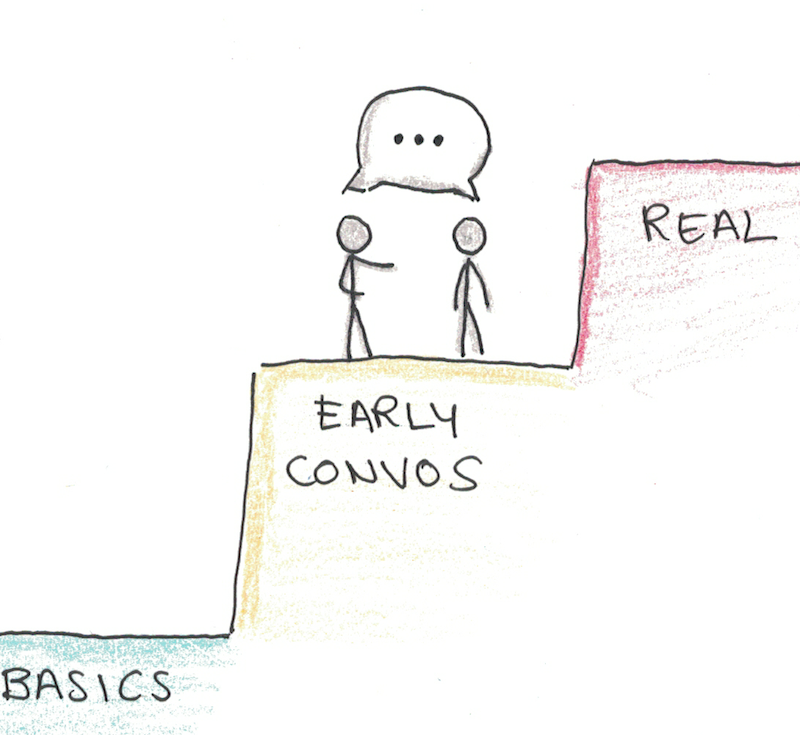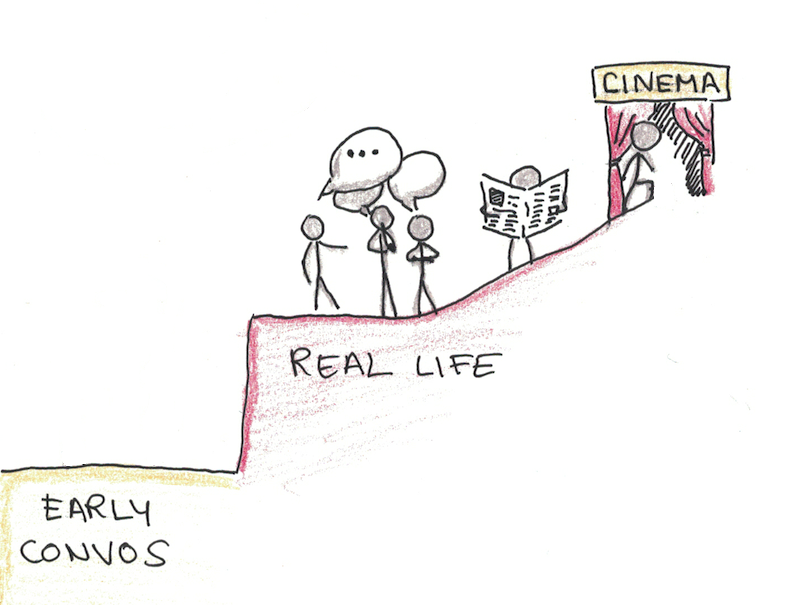Acing exams isn’t the only goal of learning. Life is full of opportunities for learning things well that will never have a final test.
Learning another language is a goal many people have. It’s also one that many people stumble on. They get stuck, give up and maybe even convince themselves they don’t have the right “gene” for learning languages.
There is no gene, however. There’s only ineffective strategies and good ones.

Why I Don’t Recommend DuoLingo
Because actually using a language is so hard in the beginning, its easy to accidentally fall into ineffective learning strategies.
I don’t recommend DuoLingo for most language learners. On the surface, this may seem surprising. The app is slick and well-designed. It has spaced repetition and procedurally-generated questions.
So what’s the problem?
The problem is that the default early-level design of each module in DuoLingo works by getting you to translate sentences by picking words out of a word bank. The problem is that this is nothing like actually speaking a language.

Note, that there is no:
- Need to recall the exact word forms, since they can be recognized from the word bank.
- Need to ignore similar or confusing words, since those rarely appear side-by-side.
- Deal with incomplete vocabulary, where you want to say a word but don’t know it and still need to communicate.
- Actual pronunciation and using your lips and mouth to produce the correct sounds.
In DuoLingo’s defense, if you keep drilling a lesson/module, it eventually does start to have more difficult and realistic forms of practice. But my suspicion is that this feature is buried on purpose because far few people would stick to the app if they had to learn it that way.
The Better Way to Learn a Language
A better way to learn a language would have three phases:
- Acquiring the minimum basic knowledge and skills to start talking to people.
- Having structured, easy conversations in an environment that facilitates learning.
- Switching to immersive learning through actual interaction with people (or media).

Let’s look at how you can approach each of these three phases.
Phase #1: Hitting the Minimum
The first goal should be short and achievable—get to a level where you can struggle through your first 15-minute conversation, with the help of dictionaries and Google Translate.
If you’re confident and willing to deal with awkwardness, this could potentially be reached in as little as thirty minutes. This is the approach recommended by Benny Lewis. This counteracts the normal tendency to wait too long to get started using the language. Thus, if you’re bold enough, I recommend diving straight in.

If you’re not so bold, or you tried speaking it and it was too discouraging, you’ll need a beginner learning resource.
Here’s my picks for best resources, in order of priority:
- Pimsleur. An older technology, and sometimes a little expensive. However, the thing it does right is that it forces you to recall and pronounce whole phrases from memory. This is exactly the training you need to give yourself that beginner foundation. Just don’t expect it to get you to fluency.
- Teach Yourself. These offer a decent overview of the language. Practice is often less automatic with these, but they do provide enough information to start having basic conversations where the real work can begin.
- Flashcards. A final strategy is to just use flashcards, from an app such as Memrise or Anki. There’s too many resources to mention here, but the main advantage they have over DuoLingo is that you must produce the whole answer in your head, rather than select them as multiple-choice or from a word bank.
Regardless of what you use, the best strategy is the one that gets you into a real conversation as soon as possible.
Phase #2: Simple Conversations
The next phase of your learning should be based on a mixture of actually speaking to someone and further deepening your knowledge of grammar and vocabulary.

For the first step, I highly recommend finding a language partner or tutor. You can find them at websites like iTalki.com and LiveMocha.co. There are also in-person language meetups through meetup.com (although group meetups tend to be harder than one-on-ones).
Next, you need to start off with a very specific kind of conversation. I recommend having this one in English first. In this conversation you’re going to explain:
- That you only want to speak in the language you’re learning (with rare exceptions).
- You’re going to use a dictionary and Google translate to fill gaps in your understanding.
- You want them to write everything down that they’re saying, if you ask them. Both to help you learn it better, but also to copy into a dictionary to understand them.
- You’ll tell them that you know it’s going to be awkward and slow, but you want them to be patient.
This warm-up conversation makes it a lot easier to not fall back onto spending the whole session doing drills, but otherwise speaking entirely in English.
From there, you need to start having conversations. I recommend starting with this being about 25% of your total practice time right at the start (with the other 75% being vocabulary acquisition and grammar practice), and you can slowly ramp up as you feel more confident.
Phase #3: Real Conversations
If you go through this process, it shouldn’t be long before you’re able to have simple conversations about familiar topics that don’t immediately retreat to the dictionary.
Once this barrier has been surmounted, you can start making a more conscious effort to have real conversations. These differ from tutored conversations in many ways (not only by being more difficult), and so having real, immersive practice is essential for really learning the language.

If you were planning an opportunity to travel to a place that speaks the language (or otherwise immerse yourself) now would be the time.
Join My Full Course!
If you find lessons like these helpful, you’ll enjoy Rapid Learner. This is my full program for turning you into a more effective learner. I’ll guide you through the step-by-step process you can use to learn anything, whether it’s a language, class, skill or hobby, as effectively as possible.


 I'm a Wall Street Journal bestselling author, podcast host, computer programmer and an avid reader. Since 2006, I've published weekly essays on this website to help people like you learn and think better. My work has been featured in The New York Times, BBC, TEDx, Pocket, Business Insider and more. I don't promise I have all the answers, just a place to start.
I'm a Wall Street Journal bestselling author, podcast host, computer programmer and an avid reader. Since 2006, I've published weekly essays on this website to help people like you learn and think better. My work has been featured in The New York Times, BBC, TEDx, Pocket, Business Insider and more. I don't promise I have all the answers, just a place to start.